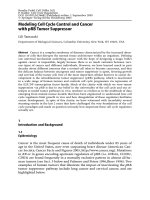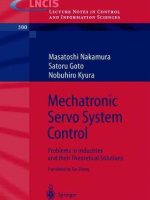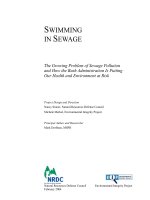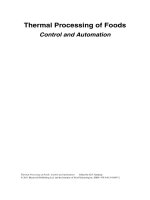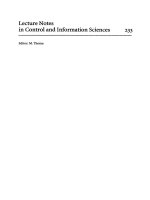Sensorless Vector Control and Implementatio - Why and How (1)
Bạn đang xem bản rút gọn của tài liệu. Xem và tải ngay bản đầy đủ của tài liệu tại đây (2.01 MB, 57 trang )
Renesas Electronics America Inc.
© 2012 Renesas Electronics America Inc. All rights reserved.
Sensorless Vector Control and
Implementation: Why and How
© 2012 Renesas Electronics America Inc. All rights reserved.2
Renesas Technology & Solution Portfolio
© 2012 Renesas Electronics America Inc. All rights reserved.3
Microcontroller and Microprocessor Line-up
Wide Format LCDs
Industrial & Automotive, 130nm
350µA/MHz, 1µA standby
44 DMIPS, True Low Power
Embedded Security, ASSP
165 DMIPS, FPU, DSC
1200 DMIPS, Performance
1200 DMIPS, Superscalar
500 DMIPS, Low Power
165 DMIPS, FPU, DSC
25 DMIPS, Low Power
10 DMIPS, Capacitive Touch
Industrial & Automotive, 150nm
190µA/MHz, 0.3µA standby
Industrial, 90nm
242µA/MHz, 0.2µA standby
Automotive & Industrial, 90nm
600µA/MHz, 1.5µA standby
Automotive & Industrial, 65nm
600µA/MHz, 1.5µA standby
Automotive, 40nm
500µA/MHz, 35µA deep standby
Industrial, 40nm
242µA/MHz, 0.2µA standby
Industrial, 90nm
1mA/MHz, 100µA standby
Industrial & Automotive, 130nm
144µA/MHz, 0.2µA standby
2010
2013
32-bit8/16-bit
© 2012 Renesas Electronics America Inc. All rights reserved.4
Challenge: Sensorless vector control increases the energy
efficiency of motor control systems that drive the smart
society. However, understanding and implementing
sensorless vector control is a herculean task.
Solution:
This class will help you understand key challenges associated with
sensorless vector control and how to implement it using Renesas
microcontrollers
‘Enabling The Smart Society’
MCU
© 2012 Renesas Electronics America Inc. All rights reserved.5
Agenda
Need for vector control
Theory behind vector control
Challenges in implementing sensorless vector control
RX62T MCU family for sensorless vector control
Renesas motor control solutions
© 2012 Renesas Electronics America Inc. All rights reserved.6
Macro Factors Driving Need for Energy Efficiency
Global
Environmental
Concerns
Energy Efficiency
Policies
New Initiatives
© 2012 Renesas Electronics America Inc. All rights reserved.7
Realizing Energy Efficiency in Motor Control
Industrial 44%
Residential 26% Others 30%
Energy Efficient
Motors
Electronic Control
Variable speed drives
Vector control
Direct torque control
Power factor correction
Motor Design
Motor Type
Up to ~30% savings
15%
20%
Motors
(45%)
© 2012 Renesas Electronics America Inc. All rights reserved.8
Sensorless Vector Control Theory
© 2012 Renesas Electronics America Inc. All rights reserved.9
Permanent Magnet AC Motor
Complex Control
Sinusoidal stator current produces rotating field
Rotor mounted magnetic field is rotating
Maintain stator field orthogonal to rotor field
rsk
λλ
×=Γ .
X
A
A’
X
B
B’
C’
X
C
A B C
θ
© 2012 Renesas Electronics America Inc. All rights reserved.10
Vector Control Challenge
Maintain orthogonality
Error correction feedback loop
– In-phase current = 0
– Orthogonal current set per torque requirements
What parameters to adjust
Voltage magnitude (PWM duty cycle)
Need to transform current vectors to rotor frame
Rotor Field
Stator Field
90
0
ω
r
© 2012 Renesas Electronics America Inc. All rights reserved.11
Reference Frame Transformation
Vector control advantages
Maximizing torque (efficiency)
Independent control of flux and torque
Snappy torque control for load variation
Mapping
q
i
d
i
2-phase Rotor Frame
Three-phase Stator
u
i
w
i
v
i
0
120
© 2012 Renesas Electronics America Inc. All rights reserved.12
Current Transformation to 2-ph Rotor Frame
Step 1 : 3-ph to 2-ph conversion
−
−−
=
c
b
a
i
i
i
i
i
2
3
2
3
0
2
1
2
1
1
β
α
−
=
β
α
i
i
I
I
q
d
cosθsinθ
sinθcosθ
u
i
w
i
v
i
F
Clarke Transformation
ω
uvw
stationary frame
α
i
β
i
F
ω
αβ
stationary frame
d
I
q
I
F
q-
axis
d-axis
Park Transformation
ω
dq
rotatory frame
Step 2 : 2-ph stationary frame to 2-ph rotor frame (rotating)
Rotor position (θ) needed
© 2012 Renesas Electronics America Inc. All rights reserved.13
Sensorless Vector Control
Lower cost but more complex implementation
Current and motor parameters to estimate rotor position
Increased reliability
Reduced cost of sensor ($3-$20)
Less physical space needed
Need to estimate θ without sensors
Speed
/position
sensor
Speed
Calculation
Motor
PWM
Generation
PI
Controller
PI
Controller
ω*
ω
i*
i
θ
Position
Estimation
i
© 2012 Renesas Electronics America Inc. All rights reserved.14
dt
d
iRv
s
α
αα
λ
+=
αα
θλ
Li
rm
+Λ= cos
ββ
θλ
Li
rm
+Λ= sin
αα
λθ
Li
rm
−=Λ cos
ββ
λθ
Li
rm
−=Λ sin
is the rotor flux linked
m
Λ
is the rotor position
r
θ
Flux LinkageVoltage Equation
=0
=0
Motor Model in
αβ
Frame
dt
d
iRv
s
β
ββ
λ
+=
Potential Inaccuracy: If full load or large motor
© 2012 Renesas Electronics America Inc. All rights reserved.15
Rotor Position and Speed Estimation
α
λθ
=Λ
rm
cos
β
λθ
=Λ
rm
sin
)arctan(
α
β
λ
λ
θ
=
r
dt
d
θ
ω
=
Bottleneck: arctan implementation takes several CPU cycles
© 2012 Renesas Electronics America Inc. All rights reserved.16
Renesas Flux Observer Model
dtiRv
s
t
)(
0
0
αααα
λλ
−+=
∫
dt
d
iRv
s
βα
βαβα
λ
,
,,
+=
α
e
Potential inaccuracy: Noise in measuring current and voltage
Potential inaccuracy: Effect of temperature on resistance
© 2012 Renesas Electronics America Inc. All rights reserved.17
βα
,
e
nnn
d+∗=
− )1(,)(,
1024
1023
βαβα
λλ
1−
−=
nnn
yyd
Low pass filter
y
n
Derivative
d
n
dt
d
Low pass filter
βα
,1
1024
1023
eyy
nn
+∗=
−
)(, n
βα
λ
Cascaded low pass filters rather than direct integration
First low pass filter
Derivative
Second low pass filter
Negate the effect of DC offset in measured current/voltage
Flux Observer Implementation
© 2012 Renesas Electronics America Inc. All rights reserved.18
Sensorless Vector Control Loop
abc
to
αβ
i
a
ib
dq
To
αβ
vα
vβ
αβ
to
abc
Speed
Estimation
θ
ωr
ω*r
id
Regulator
id*=0
i
d
iq
iq
Regulator
Speed
Regulator
Iq*
3-ph
Inverter
6
Sine
PWM
DC
BUS
αβ
to
dq
iα
iβ
θ
Flux and Position
Observer
ClarkePark
Park
-1
Clarke
-1
© 2012 Renesas Electronics America Inc. All rights reserved.19
Implementation Challenges
© 2012 Renesas Electronics America Inc. All rights reserved.20
High performance CPU, FPU
Implementation Challenges
1. Computation intensive routines
12Bit Simultaneous Sampling ADC2. Multiple current/voltage measurement
Noise immunity, PWM shut off3. Robust performance
On-chip analog, data flash, dual motor4. Cost effective design
Requirements MCU Considerations
© 2012 Renesas Electronics America Inc. All rights reserved.21
1. Computation Intensive
High-performance RX600 Core
100MHz CPU
1-cycle flash access
32x32 H/W multiplier
32/32 H/W divider
32bit Barrel Shifter
Floating point unit
• Clarke/Park Transformations
• Flux Estimation
• Rotor position and speed
© 2012 Renesas Electronics America Inc. All rights reserved.22
Floating Point Unit Advantages
Performance
Wide range and high resolution
No scaling, overflow or saturation
Reduced code size
Ease of Use
Ease of coding, reading, debugging
Compatible with the C/Matlab simulation code
© 2012 Renesas Electronics America Inc. All rights reserved.23
Floating Point : Range and Resolution
-2
10
-10
3
+2
10
+10
3
Range
Resolution 2
-21
10
-7
0
Fixed Point Q11.21
Single Precision
Floating Point
0
-10
38
+10
38
Range
Resolution 10
-39
∫ or ∑
© 2012 Renesas Electronics America Inc. All rights reserved.24
Fixed-point Calculations Requires Scaling
X(n) = X(n-1) + A1 * E(n)
(16b, Q12.4) (16b, Q8.8)(32b,Q14.18)
(32b,Q20.12)
(32b,Q14.18)
MULT
SHIFT
(32b,Q14.18)
© 2012 Renesas Electronics America Inc. All rights reserved.25
No Scaling Needed
FPU ImplementationFixed-Point Implementation
SHIFT


